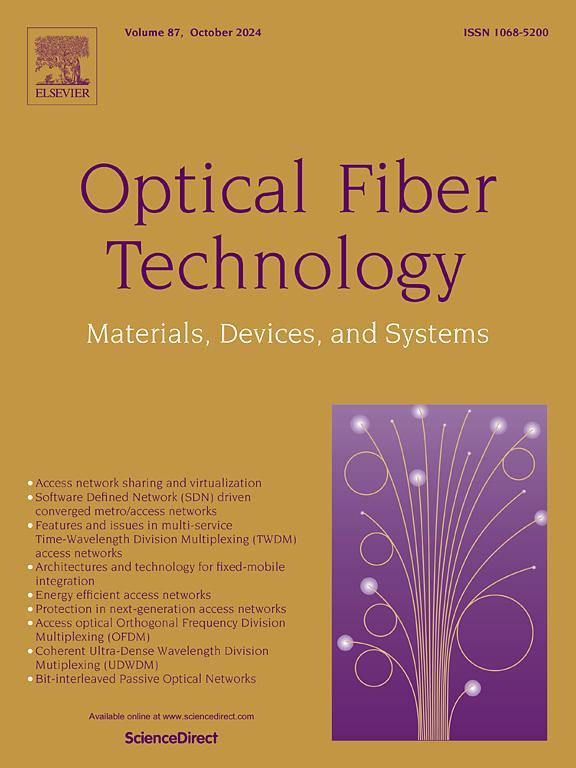Ultra-high-order QAM transmission in C-band IM/DD systems via two-stage delta-sigma modulation
IF 2.7
3区 计算机科学
Q2 ENGINEERING, ELECTRICAL & ELECTRONIC
引用次数: 0
Abstract
Radio-over-Fiber (RoF) schemes have received widespread attention in fronthaul links of fifth-generation (5G) wireless networks due to the advantages of large bandwidth and low transmission loss. To trade off the robustness and spectral efficiency (SE) of ROF, the delta sigma modulation (DSM) has been recognized as a promising alternative to common public radio interface (CPRI) for implementing novel mobile fronthaul (MFH) architectures. In this article, an intensity modulation and direct detection (IM/DD) system with a two-stage DSM structure was proposed. We proposed a two-stage 1-bit DSM to convert high-order Quadrature Amplitude Modulation (QAM) format into 4-level Pulse Amplitude Modulation (PAM-4) format, achieving the transmission of high order QAM signals through IM/DD links. The two-stage DSM architecture achieves a signal-to-noise ratio (SNR) of 58 dB by suppressing in-band quantization noise (QN) introduced through first-stage DSM quantization via subsequent second-stage DSM processing, thereby enabling support for 65536-QAM signal transmission. We demonstrated the transmission of a 56-Gbaud DSM-PAM-4 signal in the C-band over a 2-km fiber link. The results show that the proposed system is capable of supporting up to 65536-QAM signals while achieving a bit error rate (BER) below the hard-decision forward error correction (HD-FEC) threshold of 3.8e-3.
采用两级δ - σ调制的c波段IM/DD系统中的超高阶QAM传输
光纤无线电(Radio-over-Fiber, RoF)方案由于具有带宽大、传输损耗低的优点,在第五代(5G)无线网络的前传链路中受到了广泛的关注。为了权衡ROF的鲁棒性和频谱效率(SE), delta sigma调制(DSM)已被认为是实现新型移动前传(MFH)架构的有前途的公共无线电接口(CPRI)的替代方案。本文提出了一种两级DSM结构的强度调制直接检测(IM/DD)系统。我们提出了一种两级1位DSM,将高阶正交调幅(QAM)格式转换为4级脉冲调幅(PAM-4)格式,实现了通过IM/DD链路传输高阶QAM信号。两级DSM架构通过后续的第二阶段DSM处理来抑制第一阶段DSM量化带来的带内量化噪声(QN),从而实现了58 dB的信噪比(SNR),从而支持65536-QAM信号传输。我们演示了在2公里光纤链路上在c波段传输56 gbaud的DSM-PAM-4信号。结果表明,该系统能够支持65536-QAM信号,同时误码率(BER)低于硬决策前向纠错(HD-FEC)阈值3.8e-3。
本文章由计算机程序翻译,如有差异,请以英文原文为准。
求助全文
约1分钟内获得全文
求助全文
来源期刊

Optical Fiber Technology
工程技术-电信学
CiteScore
4.80
自引率
11.10%
发文量
327
审稿时长
63 days
期刊介绍:
Innovations in optical fiber technology are revolutionizing world communications. Newly developed fiber amplifiers allow for direct transmission of high-speed signals over transcontinental distances without the need for electronic regeneration. Optical fibers find new applications in data processing. The impact of fiber materials, devices, and systems on communications in the coming decades will create an abundance of primary literature and the need for up-to-date reviews.
Optical Fiber Technology: Materials, Devices, and Systems is a new cutting-edge journal designed to fill a need in this rapidly evolving field for speedy publication of regular length papers. Both theoretical and experimental papers on fiber materials, devices, and system performance evaluation and measurements are eligible, with emphasis on practical applications.
 求助内容:
求助内容: 应助结果提醒方式:
应助结果提醒方式:


